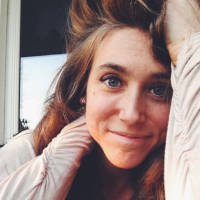
“Nothing ever goes away until it has taught us what we need to know.” ~ Pema Chödrön
~
I started yoga almost 12 years ago when my sister asked me to buy her a yoga DVD.
She told me to just choose one from the store since I was going that day. Most people probably wouldn’t consider the one I chose yoga—it was more like a fitness video—but I loved it.
I couldn’t “do” most of the poses, but I loved feeling the little changes that happened. I loved noticing the strength I was building and how flexible I was becoming.
I think I did that DVD every day for about a year, and over time bought other DVDs and found other teachers and videos and books. And then I started going to classes, and after a few years, I took a yoga teacher training and became a certified yoga teacher.
I loved yoga. I practiced in classes several times a week, and I practiced on my own.
Over time, though, I started to notice a certain mental tendency creep up in classes. I noticed myself feeling competitive, like I had to be the best—always needing to do the most advanced pose and always wanting to be the deepest one in a pose. I also craved the validation I’d get when a teacher told me I was doing well.
One night after an evening class, a woman came over to me. She was a yoga teacher and I think that she also owned a yoga studio in the city. She told me that my Warrior 1 was one of the deepest she’d seen.
Oof. Did my ego love that!
I became even more obsessed with being the deepest in Warrior 1 and Warrior 2…and so on.
Eventually, though, when I became more and more aware of this competitive energy, I realized how uncomfortable it made me feel, how much I didn’t like it. I knew it wasn’t the point of yoga, and I didn’t like how it made me feel. I didn’t like being so preoccupied with this.
So, I started to challenge myself to not do the most advanced version of a pose. Instead of going into headstand or another arm balance, I’d stay in whatever first option there was.
It didn’t really help my competitiveness though, and I eventually decided to stop going to classes altogether. I decided to just practice at home, on my own. I didn’t want to deal with all of that competitive energy anymore. If I practiced on my own, I wouldn’t care how I looked or whether other people were looking at me. I wouldn’t need to do the most advanced pose or be the deepest in it. I could just move and flow in whatever way felt right, in a way that felt good and right each day.
I found peace in my yoga practice again.
However, while my intentions were pure, what I didn’t realize at the time was that I was just avoiding a lesson. I wasn’t actually dealing with the undercurrent of competitive energy; I was just snipping off the source of the current trigger for that energy.
That energy and the source for it still existed within me.
I hadn’t gotten rid of it; I simply left it without an outlet.
Years later, I would face the same energy in different situations. When I first saw it pop up again, I felt the familiar frustration—I felt so frustrated that I still had this within me, that I still had to deal with it.
But after years of cultivating self-awareness and training myself to sit with discomfort, I was able to see the underlying reasons for it. I was able to look at it and face it. I could see what that competitiveness really meant, what lingered beneath it, what it was trying to tell me. I was able to learn from it.
Truthfully, I still see it pop up from time to time, but because I now know what it means, where it stems from, I know how to deal with it. I know what it’s trying to tell me. And I know how to be present with it and with myself, while also choosing to cultivate a new pattern of thinking, as I actively, consciously choose to rewire the thoughts and beliefs that live beneath it.
We can’t free ourselves from things if we’re unwilling to face them. We can’t discover the sources of our discomfort by bypassing or avoiding what makes us feel uncomfortable. We can’t learn our lessons if we’re unwilling to become aware, if we’re unwilling to pay attention, if we’re unwilling to be present and open and self-honest.
We can learn and grow and change through sitting with ourselves and being present, through being willing to face our pain and our discomfort, through being willing to admit to thoughts, feelings, and beliefs that we’d rather not think or feel or have.
We can even do this in a more easeful way if we are compassionate and gentle with ourselves, if we understand that we’re always doing the best we can, and if we understand that this process of self-awareness is a journey.
The more we’re able to sit with ourselves, look within ourselves, observe what’s happening within us, the more self-aware we’ll become, the more connected to and grounded within ourselves we’ll become, and the more we’ll be able to work through the parts of us and the parts of life that feel uncomfortable.
We’ll be able to learn our lessons.
~

 Share on bsky
Share on bsky




Read 12 comments and reply